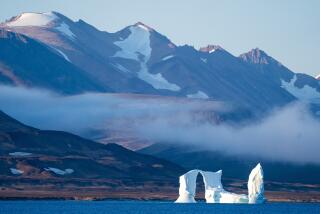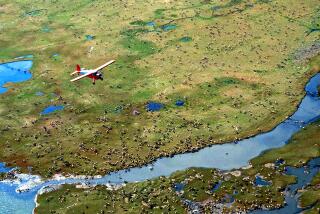Limited Arctic Drilling Won’t Harm Caribou, Scientists Say
Setting the stage for a contentious debate on oil drilling in the Arctic National Wildlife Refuge, government scientists have concluded that oil wells limited to the northwest corner of the refuge would do little or no harm to the thousands of caribou who bear their young on the coastal plain.
In a follow-up of an earlier report, the U.S. Geological Survey concluded that predictions that oil drilling would impair caribou reproduction and survival do not hold true if the eastern half of the Arctic coastal plain is left untouched, a plan now under consideration by some drilling proponents.
“The impact was minimal on the Porcupine caribou herd,” Interior Department spokesman Eric Ruff said of the new two-page report, prepared by USGS biologists and scheduled for release this week.
The biologists were ordered to take another look at the issue after their earlier assessment of wildlife impacts considered a wider range of drilling scenarios that left its findings open to debate.
The new report could influence the oil-drilling debate, as the Senate prepares to resume debate this week on energy legislation. For the first time, drilling proponents come to the hearings armed with scientific cover for tapping the portion of the refuge thought most likely to contain readily accessible oil.
Critics dismissed the revised findings, however, saying they do not provide a realistic assessment because they look only at what happens if caribou are prevented from calving in the northwest quadrant. They do not examine whether that area might be important to caribou in other ways, said Ken Whitten, a caribou biologist who contributed to the original report.
“We can be pretty confident that there would be impacts, but we don’t have a model yet to measure them,” Whitten said.
The 123,000 caribou are the most visible of the thousands of wildlife--birds, grizzly bears, polar bears, musk oxen and others--that inhabit the narrow, 1.5 million-acre coastal plain of the Arctic refuge, America’s largest wildlife reserve and its most northern.
The annual migration of the herd--named after the Porcupine River--from the mountains of Canada to the Arctic coast is North America’s last great mammal migration, and the spring and summer weeks spent along the coast, relatively free of insects and predators, is thought to be crucial to survival of the herd.
Federal officials estimate there are 5.7 billion to 16 billion barrels of oil underneath the coastal plain, and the original USGS report looked at how wildlife would be affected under a range of five development scenarios for extracting that oil.
The original findings, unveiled March 29, ranged from little to no effect on wildlife, if oil drilling is limited to the western edge of the refuge, to a decrease of as much as 8.2% in caribou calf survival, if there is massive development of the plain. Though that number seems small, biologists say it could be potentially crippling to the herd’s viability.
After its release, USGS Director Charles G. Groat asked the authors to go back to the table and evaluate additional scenarios. Over the last week, they looked at what would happen if oil wells were limited to the area that the USGS believes is most likely to contain exploitable oil reserves, in the northwest quadrant.
The House, in its version of the energy bill, limited oil development at ANWR to 2,000 acres, presumably in the geologically accessible lands of the northwest.
The authors also looked at development in lands controlled by Native Alaskans who have a share in oil reserves within the refuge.
USGC biologist Brad Griffith, who authored the original caribou report, said in this latest study that the USGS computer model, which looks at what would happen if calving caribou were displaced by oil development in the northwest quadrant, found changes in calf survival rates ranging from a 1.4% improvement to a 2.9% decline, with an average of a 0.7% decline--essentially negligible.
“Any displacement that’s less than 10 kilometers total in the model as an average resulted in little or no change in the June calf survival,” said an Interior official familiar with the report.
The problem, Whitten said, is that applying the computer model to the northwest quadrant is unrealistic, because very few caribou use the quadrant for calving. On the other hand, about 30% of the herd uses that area after calving, an indication that it may provide valuable forage or insect protection that is vital but cannot be measured simply by looking at calf distribution, Whitten said.
“We don’t have ready-made models to estimate [impacts in this area] like we do on [the rest of] the coastal plain,” he said.
*
Times staff writer Elizabeth Shogren contributed to this report.
More to Read
Sign up for Essential California
The most important California stories and recommendations in your inbox every morning.
You may occasionally receive promotional content from the Los Angeles Times.










